|
|
| |
|
|
| |
|
|
|
|
| |
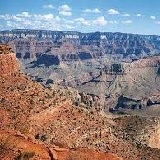 Travel
America Travel
America
Learn before you travel. This section of Fun Easy
English focuses on facts and other cool stuff about
your favorite U.S. state. This is great English
reading practice. This page focuses on the state of
Wyoming. |
 Hey
if you cannot understand something on this page, Hey
if you cannot understand something on this page,
then use the Fun Easy English
dictionary
(opens in a new window) |
|
|
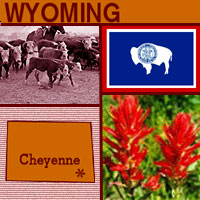 Wyoming Wyoming
Wyoming gets its name from the Algonquin words for
"land of vast plains." After the Union Pacific
Railroad reached the town of Cheyenne, the capital,
in 1867, the population began to grow steadily in
the Wyoming Territory, established in 1868. Wyoming
was admitted as the 44th state in 1890. The
constitution of the "Equality State" was the first
in the world to grant voting rights to women.
Wyoming was also the first state to elect a woman
governor. People are spread out across the state in
small farming and ranching towns, and millions of
visitors come to enjoy the Yellowstone and Grand
Teton national parks each year. The state flower has
the poetic name of Indian paintbrush. Wyoming is the
smallest state in the Union in population. |
|
Wyoming
State Flag
Wyoming was one of the last states to ratify an
official state flag in 1917.
In 1916 an open competition was held by Wyoming's DAR
(Daughters of the American Revolution) for the design of an
official Wyoming flag. Between 37 entries, Verna Keays won
the $20 first-place prize with her design of a bison
(Wyoming's official state mammal) with the state seal
branded at its center. Her design was made official by
legislature in 1917.
In Verna's original design, the bison faced away from the
staff as a symbol of the freedom with which the bison had
once roamed over the Wyoming plains. Dr. Grace Raymond
Hebard (state regent for the DAR at the time), felt the
design would be more balanced with the bison facing the
staff. The first flags were printed this way, and though
Wyoming legislation has not officially recognized this
change, Wyoming flags have been printed with the bison
facing the staff since 1917.
The red, white, and blue colors of the state flag are the
same as those of the national flag. The red on the border is
a symbol of the native Americans who inhabited Wyoming long
before settlers came, and also represents the blood of
pioneers who gave their lives to claim the soil. White is a
symbol for the purity and uprightness of Wyoming. Blue is
for Wyoming's sky and mountains, and is also a symbol of
fidelity, justice and virility. |
|
Source:
State Symbols USA |
|
|
 Wyoming
State Facts Wyoming
State Facts
Picture: state seal of Wyoming |
|
State Capital |
Cheyenne |
|
Nickname |
Equality State / Cowboy State |
|
Motto |
Equal Rights. |
|
Statehood |
July 10, 1890 (44th) |
|
Origin of Name |
Based on an Algonquin Indian word meaning "large
prairie place" |
|
Largest Cities |
Cheyenne |
|
Border States |
Colorado, Idaho, Montana, Nebraska, South Dakota,
Utah |
|
Area |
97,105 sq. mi., 9th largest |
|
State Bird |
Western Meadowlark |
|
State Flower |
Indian Paintbrush (castilleja linariaefolia) |
|
State Tree |
Cottonwood (populus sargentii) |
|
State Song |
Wyoming |
 Travel and tourism
site for Wyoming - This state travel and territorial
tourism site provides ideas for your vacations, meetings, and more. Travel and tourism
site for Wyoming - This state travel and territorial
tourism site provides ideas for your vacations, meetings, and more. |
|
|
Wyoming Stories |
|
|
Cheyenne Frontier Days
A bull named Mr. T was one mean bull!
In the 1920s bull riding was added as an event to Frontier Days, a
celebration of cowboy culture that was first held in 1897 in
Cheyenne, Wyoming. Bulls had names like Bad to the Bone and Mr. T.
More than 180 cowboys tried to ride Mr. T, but he threw them all
off. The longest any of them was able to stay on was eight seconds!
In the period following the Civil War, cowboys came to Wyoming
looking for adventure and opportunity. They were skilled and
fearless horsemen who herded longhorn cattle up the trails from
Mexico and Texas to provide beef to various military posts in the
Wyoming territory. The town of Cheyenne, located along the Union
Pacific Railroad in the heart of ranch land, was trying to attract
business and people. So, in 1896, a group of cowboys decided to hold
a contest.
The following year, the first Frontier Days celebration took place.
The cowboys roped steers and demonstrated rope tricks. They also
challenged each other in the activity that is a true test of a
cowboy's skill -- riding a bucking bronco (a wild horse that has a
tendency to buck, or throw, its rider).
Cheyenne no longer has a problem attracting people. The Frontier
Days celebration attracts more than 180,000 visitors! |
|
|
Wyoming's Old Faithful
What is Old Faithful and why have millions of people traveled to
Wyoming to see it?
Yellowstone National Park, part of which is in Wyoming, is home to
more geysers than any other place in the world. The most famous
geyser is Old Faithful, which got its name because its eruptions can
be so reliably predicted. A geyser is a spring that sprays out
blasts of heated water and steam. The park has plenty of hot
springs. In a geyser, steam and water build pressure beneath a
narrow passageway in the ground. Steam forces the water up, and
sudden changes in underground water temperature create violent
explosions of water and steam on the surface. Some geysers erupt in
bursts, some at angles, and some from cone-shaped rock formations,
such as Castle Geyser, pictured here. Yellowstone's hot springs also
form steam vents, mudpots, and vividly colored pools. The park's
geysers, like Steamboat and Old Faithful, however, are far more
famous. |
|
Source:
Library of Congress |
|
 National
Forests, Parks, and Monuments of Wyoming National
Forests, Parks, and Monuments of Wyoming
The following is a description of national
forests, parks, and monuments in the state
of Wyoming. If you plan to visit or live in
Wyoming for awhile then you should
definitely plan to visit some of these
fantastic places. |
|
|
|
National Forests |
 Ashley Ashley
Ashley National Forest manages the Flaming
Gorge National Recreation Area and the High
Uintas Wilderness. Kings Peak at 13,528 ft
(4,123 m) is the highest point in Utah and
is located in the Uinta Mountains. This
national forest is also partially located in
the state of Utah. |
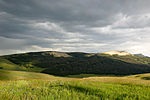 Bighorn Bighorn
In the Big Horn Mountains of north-central
Wyoming, Bighorn National Forest has eight
lodges, several reservoirs, and 1,500 mi
(2,400 km) of trails. Elevation reach 13,167
ft (4,013 m) at Cloud Peak in the Cloud Peak
Wilderness, which is also the location of
the Cloud Peak Glacier. |
 Black
Hills Black
Hills
Consisting predominately of Ponderosa pine,
this forest is located in the namesake Black
Hills. There are 11 reservoirs, 353 mi (568
km) of trails, and 1,300 mi (2,100 km) of
streams in this forest. Black Elk Peak is
the highest point in South Dakota and the
highest point in the United States east of
the Rocky Mountains at 7,244 ft (2,208 m).
This national forest is also partially
located in the state of South Dakota. |
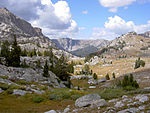 Bridger-Teton Bridger-Teton
As part of the Greater Yellowstone
Ecosystem, Bridger-Teton National Forest has
27 glaciers in its portion of the Wind River
Range. The Gros Ventre landslide formed a
dam on the Gros Ventre River in 1925 before
failing in 1927. |
 Caribou-Targhee Caribou-Targhee
The forest's Jedediah Smith Wilderness has
many caves and the Winegar Hole Wilderness
protects grizzly bear habitat in the Greater
Yellowstone ecosystem. The Upper and Lower
Mesa Falls are on Henrys Fork of the Snake
River and tours of Minnetonka Cave are
available. This national forest is also
partially located in the state of Wyoming. |
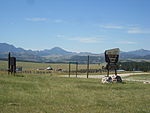 Medicine
Bow – Routt Medicine
Bow – Routt
This forest contains many ranges of the
Rocky Mountains with elevations ranging from
5,500 ft (1,700 m) to 12,940 ft (3,940 m).
There are ten wilderness areas and Rob Roy
Reservoir, which covers 500 acres (200 ha).
This national forest is also partially
located in the state of Colorado. |
 Shoshone Shoshone
Located in the Greater Yellowstone
Ecosystem, this forest includes part of the
Absaroka, Beartooth, and Wind River mountain
ranges. Five wilderness areas make up 56% of
the forest, and elevations reach 13,804 ft
(4,207 m) at Gannett Peak, the highest point
in Wyoming. |
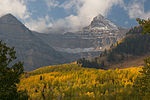 Uinta-Wasatch-Cache Uinta-Wasatch-Cache
There are nine wilderness areas in the
forest, which occupies part of the Wasatch
and Uinta mountains. Mount Nebo and Mount
Timpanogos are located in wilderness areas
at the edge of the Wasatch Front. This
national forest is also partially located in
the states of Idaho and Utah. |
|
|
|
National Parks |
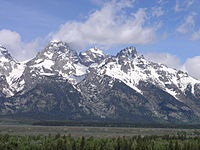 Grand
Teton Grand
Teton
Grand Teton is the tallest mountain in the
Teton Range. The park's historic Jackson
Hole and reflective piedmont lakes teem with
endemic wildlife, with a backdrop of craggy
mountains that rise abruptly from the
sage-covered valley. |
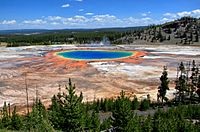 Yellowstone Yellowstone
Situated on the Yellowstone Caldera, the
park has an expansive network of geothermal
areas including boiling mud pots, vividly
colored hot springs such as Grand Prismatic
Spring, and regularly erupting geysers, the
best-known being Old Faithful. The
yellow-hued Grand Canyon of the Yellowstone
River contains several high waterfalls, and
four mountain ranges traverse the park. More
than 60 mammal species including gray
wolves, grizzly bears, black bears, lynxes,
bison, and elk, make this park one of the
best wildlife viewing spots in the country.
This national park is also partially located
in the states of Idaho and Montana. |
|
|
|
National Monuments |
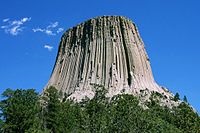 Devils
Tower Devils
Tower
The tower is a monolithic igneous intrusion
of volcanic neck rising dramatically 1,267
feet (386 m) above the surrounding terrain.
Proclaimed by Theodore Roosevelt, this was
the first national monument. |
 Fossil
Butte Fossil
Butte
Fossil Butte preserves the
50-million-year-old Green River lake beds,
the best paleontological record of tertiary
aquatic communities in North America.
Fossils including fish, alligators, bats,
turtles, dog-sized horses, insects, and many
other species of plants and animals suggest
that the region was a low, subtropical,
freshwater basin when the sediments
accumulated, over about a 2-million-year
period. |
|
|
|
|
Travel America |
|
|
Grand Teton National Park
(Beginner - Listening,
reading)
A video lesson which shows you an interesting place in America.
The English is
spoken at 75% of normal speed.
Great English listening and reading practice.
This video is all about Grand Teton National Park. |
|
|
|
|
|
|
|
|
Cool America |
 About the U.S.A. About the U.S.A.
About the U.S.A. is an American
Studies reader that examines the customs, government, and history of the
United States of America. The text provides a wealth of information on U.S.
geography and history; the roles of local, state, and federal government;
national holidays and symbols; the Constitution; and citizenship. The book,
which was written for intermediate to advanced learners of English, contains
a range of activities for language students to practice listening, speaking,
reading, and writing. (opens to a new PDF window)
Great English reading
practice. |
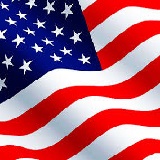 About
America About
America
Learn about the fascinating history and government of
the United States of America. Lessons include content on
American Government, American History, and Integrated
Civics. Handouts with interactive games and
student-centered activities encompass all four language
skills: speaking, listening, reading, and writing.
Great English reading practice for
beginning to intermediate students. |
 American Teens Talk! American Teens Talk!
Americans Teens Talk! is a collection of interviews of
American high school students. Each interview is accompanied by vocabulary
notes and discussion questions. The interviews in American Teens Talk! give
learners a view into the lives of adolescents in the U.S. Through the
written format of the interviews, learners are able to increase their
vocabulary, practice their reading and listening skills, engage in
discussions, and learn more about U.S. culture. These
interviews come with audio programs.
Great English listening and
reading |
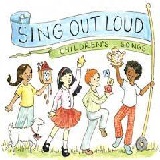 Sing Out Loud Children's Songs Sing Out Loud Children's Songs
Sing Out Loud Children's Songs includes popular children's songs in the U.S.A. Posters accompany the
individual Sing Out Loud Children's Songs. These
songs come with audio programs.
Great English listening and reading
practice. |
 Sing Out Loud Traditional Songs Sing Out Loud Traditional Songs
The Sing Out Loud Traditional Songs
collection contains 13 traditional American folk songs and song lyrics.
Listen to the songs online, read the lyrics, and collect the posters that
accompany the songs. These
songs come with audio programs.
Great English listening and reading
practice. |
 Sing Out Loud American Rhythms Sing Out Loud American Rhythms
Do you love music? Want to use it
to learn English? Check out the hip-hop inspired song "Peace" from Sing Out
Loud American Rhythms. American Rhythms includes a variety of musical genres
from many different artists in the U.S.A. These songs will appeal to teens
and young adults. These
songs come with audio programs.
Great English listening and reading
practice. |
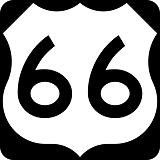 Route
66 - Famous American Road Route
66 - Famous American Road
U.S. Route 66 (US 66 or Route 66), also known as the Will Rogers Highway, the
Main Street of America or the Mother Road, was one of the original highways in
the U.S. Highway System. The highway, which became one of the most famous roads
in the United States, originally ran from Chicago, Illinois, through Missouri,
Kansas, Oklahoma, Texas, New Mexico, and Arizona before ending in Santa Monica,
California, near Los Angeles, covering a total of 2,448 miles (3,940 km). It was
recognized in popular culture by both the hit song "(Get Your Kicks on) Route
66" and the Route 66 television show in the 1960s. |
Route 66: The Highway That's the Best
(Beginner - Listening)
A video lesson which shows you an interesting place in America.
The English is
spoken at 75% of normal speed.
Great English listening practice.
This video shows travel along Route 66, the most famous road in
America. |
Chicago: The Start of Route 66
(Beginner - Listening)
A video lesson which shows you an interesting place in America.
The English is
spoken at 75% of normal speed.
Great English listening practice.
This video shows travel along Route 66, the most famous road in
America. |
Going West for Decades on Route 66
(Beginner - Listening)
A video lesson which shows you an interesting place in America.
The English is
spoken at 75% of normal speed.
Great English listening practice.
This video shows travel along Route 66, the most famous road in
America. |
Arizona: The Spirit of Route 66
(Beginner - Listening)
A video lesson which shows you an interesting place in America.
The English is
spoken at 75% of normal speed.
Great English listening practice.
This video shows travel along Route 66, the most famous road in
America. |
Route 66 California: The End of the Trail
(Beginner - Listening)
A video lesson which shows you an interesting place in America.
The English is
spoken at 75% of normal speed.
Great English listening practice.
This video shows travel along Route 66, the most famous road in
America. |
Ten Must-See Route 66 Attractions
(Beginner - Listening)
A video lesson which shows you an interesting place in America.
The English is
spoken at 75% of normal speed.
Great English listening practice.
This video shows travel along Route 66, the most famous road in
America. |
Four Famous Foods On Route 66
(Beginner - Listening)
A video lesson which shows you an interesting place in America.
The English is
spoken at 75% of normal speed.
Great English listening practice.
This video shows travel along Route 66, the most famous road in
America. |
International Tourists Drawn to Route 66
(Beginner - Listening)
A video lesson which shows you an interesting place in America.
The English is
spoken at 75% of normal speed.
Great English listening practice.
This video shows travel along Route 66, the most famous road in
America. |
|
|
|
|
Search Fun Easy English |
|
|
|
|
|
|
|
|
|
|
|
|
|
|
|
About
Contact
Copyright
Resources
Site Map |